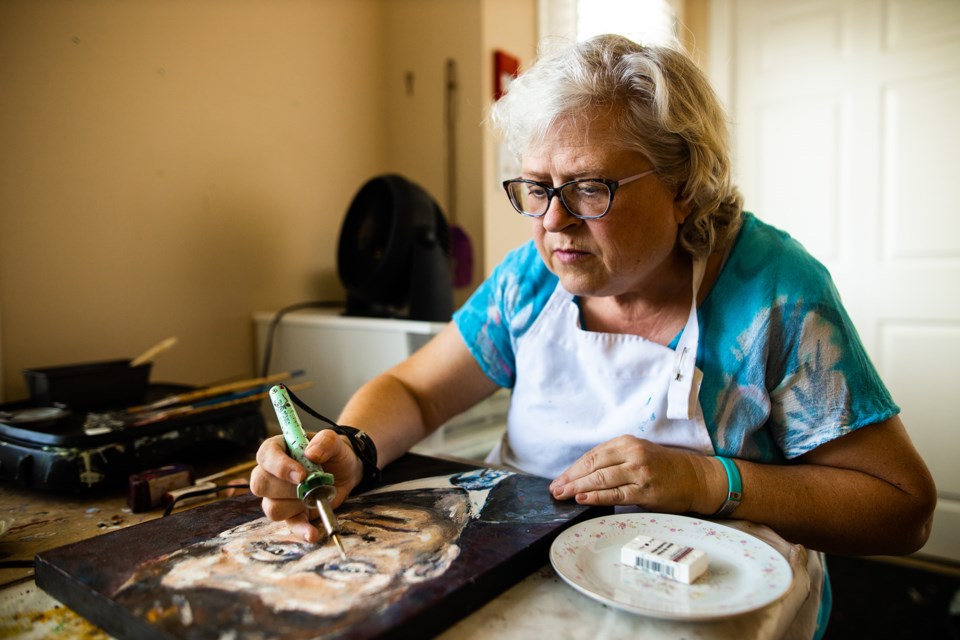A Black Diamond artist’s struggles with mental and autoimmune illnesses prompted her to use her skills to bring “invisible” illnesses to light.
Penny Gunderson created a series of encaustic paintings depicting herself and historical and popular figures who suffered from invisible illnesses from PTSD to autism for Calgary’s SPARK Disability Art Festival.
Gunderson, a current RBC Emerging Visual Artist through the festival, practices the ancient art medium of encaustic, melted beeswax, tree resin and pigments painted and then fused with heat to a wooden substrate in layers.
“Because people don’t see a cast on your arm or a wheelchair, there isn’t an understanding that there are challenges,” she said. “Your whole world has changed because you’re not capable of some of the things you were before.”
The 59-year-old suffers from several autoimmune diseases, including Addison’s disease, as well as mental health issues like seasonal depression and anxiety.
Her series, Personal Panorama, will feature two sections in which the human form becomes a landscape, presenting the idea of chronic illness and the slowing of the body’s pace being similar to the seasons.
The image Anger Flows is a portrayal of Gunderson burying her head in her hands and becoming volcanic mountains, her hair flowing lava. It represents the release of grief, anger and frustration into acceptance.
“Anger Flows deals with the grief and the coming to realize that you are not the same as you were before,” she said. “It relates to nature and how it adapts after a disaster to rejuvenate itself in a new way.”
Green Hills portrays Gunderson lying sideways on a hospital bed, her body becoming the Foothills landscape.
“So much of our life is very rapid, very multi-tasking,” she said. “I came to really appreciate the quiet things, the slow things. It’s a matter of accepting that there is a pace that your body requires that you cannot push past. It forces you to slow down like the seasons and become one with nature.”
Personal Panorama will hang in a window at the 9th Avenue entrance to the Arts Commons, in conjunction with five other installations in the exhibition, Changemakers, Sept. 9 to Dec. 8, with an artists’ reception Nov. 29.
While Personal Panorama depict Gunderson’s own journey, her exhibition, Invisible Illness Icons, as part of the festival’s new Solo Artist Series, addresses illnesses suffered by those close to her. It will be on exhibit at Studio C in cSpace Sept. 5-25.
“I thought of all the people I knew in my family and friend circles and those are the diseases that I chose to feature,” she said. “Diabetes runs very strongly in my family and we have several young family members who are on the autism spectrum.”
Gunderson was one of seven artists living with disabilities selected to present. She will speak briefly about encaustics as an art form and how mental illness affected her subjects’ lives on Sept. 12 between 5 p.m. and 7 p.m.
Invisible Illness Icons consist of large portraits of modern-day icons matched with the triptych altarpiece of historical figures.
Historical figure Jane Austen and modern figure John F. Kennedy represent rare diseases; Albert Einstein and Temple Grandin represent autism; Edgar Allan Poe and Robin Williams represent bipolar disorder; Julius Caesar and Prince represent epilepsy; Alexander Graham Bell and Aretha Franklin represent diabetes; and Florence Nightingale and First Nations author Richard Wagamese represent PTSD.
In the altarpieces, Gunderson used metal leafing and symbolic items in the side panels that indicate the personality and career of the portrait icon. The movie poster-like portraits of the current day icons are highlighted by glimpses of metal leafing in earrings, outlines and halo-like lighting effects.
“With invisible illnesses some people had great successes in their life in spite of having some very significant health issues,” she said. “If you look at the historical people, it gives you hope. Some of them succumb to the problems and some of them found a way to flourish in spite of those issues.”
Raising awareness around invisible illnesses helps take away the stigma, said Gunderson.
“We come to realize that we all have people in our lives that are struggling with these issues,” she said. “Making the invisible visible is what I’m trying to do so it can be talked about so it’s not stigmatized. There are a lot of people who suffer in silence.”
Gunderson said she suffered in silence for many years.
“I tried very hard not to acknowledge my illness in my workplace or other places until it came to a point where I was forced out of work because of my disability,” she said.
Now Gunderson is taking a different approach.
“My idea is to get a conversation started,” she said. “Sometimes we don’t talk about these things with family or friends. We don’t talk about the limitations or the changes that are forced on people because of the illnesses.”
Being accepted to present at the festival came with the opportunity for professional development, where the selected artists will learn how to write grant proposals, how to set up web pages and connect with industry professionals like gallery owners and museum curators.
“It’s a wonderful opportunity for the six people that have been chosen for that,” she said.
Invisible Disabilities Week runs Oct. 13-19.




